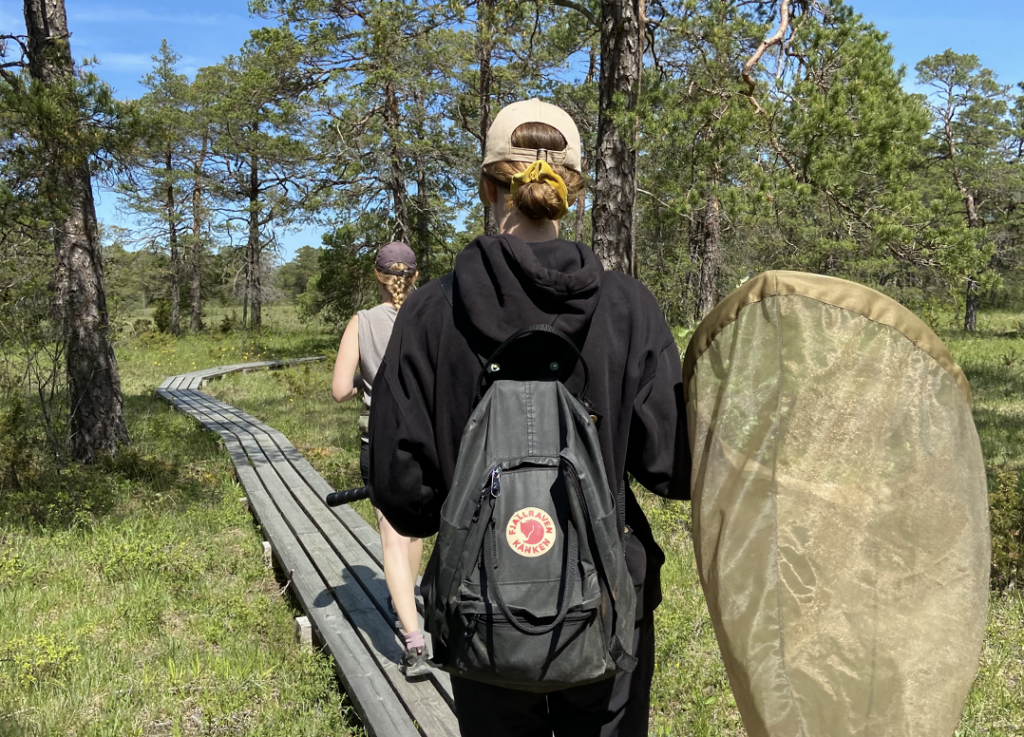With this study, I found that the marsh fritillary on Gotland is affected by several factors at varying spatial scales. Imago abundance is influenced by connectivity, bush cover, open land, ground moisture, and grazing. Larvae occurrence is determined by host plant abundance, vegetation height, the presence of tussocks, and the number of host plant stems. Population changes over time showed a negative impact from the 2018 drought, but restored areas showed increased numbers indicating successful restoration efforts.
Habitat preferences
The marsh fritillary’s preference for wet habitats may be directly linked to the survival of its host plant, which occurs in wet grasslands and damp soils. While connectivity is crucial for the species as it enables individuals to move between patches and colonize new areas. Low bush cover can provide shelter and reduce wind exposure, which could explain the positive correlation with imago butterfly presence. However, excessive bush cover could harm the butterfly population by shading the area and hindering the growth of the host plant. Open land is beneficial for the abundance of the marsh fritillary, while high tree cover had a negative effect on the population. As high tree density can reduce habitat quality for the butterfly by creating a dense canopy that shades the habitat. This again could lead to a decline in food and nesting resources for the larvae. Grazing also negatively affects the butterfly’s population, particularly when it is too intense. This type of grazing causes fewer and smaller host plants, which are often pressed to the ground. Additionally, grazing can increase the risk of unintentional predation.
The importance of host plants for the occurrence of larval nests is crucial for the survival and reproduction of the marsh fritillary butterfly on Gotland, as the larvae feed exclusively on this plant. My results also indicate that the larvae prefer shorter vegetation. While previous research has emphasized the significance of host plants and vegetation height, my study also reveals the potential benefits of tussocks and host plant stems in presumably creating elevated habitats for the larvae nests, which could potentially help them survive flooding events during the summer.
Vegetation parameters across different years
The number of host plants and their leaf length had not yet fully recovered to pre-drought levels even four years after the drought in 2018. This suggests that the drought might have had a more significant and long-lasting impact on the environment and the species that depend on these plants for survival than was perhaps previously believed. The marsh fritillary relies on wet grasslands and during a drought, these habitats may become too dry to support the host plants and nectar plants. The vegetation’s slow recovery indicates increased vulnerability to future environmental stressors. To ensure the long-term survival of the marsh fritillary in the face of climate change and more frequent extreme weather events like droughts, it is essential to establish a network of large and diverse habitats with varying moisture levels that can provide suitable conditions in both dry and wet weather years.
Imago density estimation over time
The population of marsh fritillary in the two larger restored areas has increased over the past two years, while the overall population in Filehajdar has declined. This indicates an improvement in habitat quality following restoration. The population in the smaller restored area from 2017 remained stable over the past two years, but limited data points make it difficult to assess population trends or habitat quality accurately. This area is also the least connected, which further underscores the importance of maintaining high connectivity, as this may be a contributing factor to why this area hosts the fewest marsh fritillary individuals.
Larvae density estimation
The smaller restored area from 2017 was not used as a breeding ground by the marsh fritillary butterfly until 2022, despite the presence of larvae colonies in a patch just north of it. The restoration aimed to increase sunlight by removing trees and bushes, thereby turning the previously shaded areas into a more favourable habitat for the marsh fritillary. The discovery of the first larvae colony in the adjacent area in 2021 and the presence of a nest inside the restored area in 2022 prove the success of the restoration, which can positively impact both the restored area and surrounding areas previously affected by shading. In contrast, the other two restored areas were quickly utilized as breeding grounds after their restoration, likely due to their larger size and better connection to the main population.
